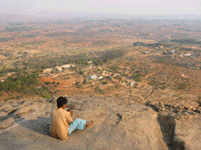 TOURISM TOURISM |
Madagascar is plainly an invitation to discovery. Those who come back agree on this. Nature, History and people seem to get together to make this destination increasingly appreciated. 5000 Km of coasts fringed by superb beaches, 70% of the world's species of Lemurs, 190 types of amphibians, 250 kinds of reptiles, 1000 varieties of orchids, more than a hundred classified sites and monuments and a protected area of 1.2 million hectares. With so many aces Madagascar is a real paradise for seekers, naturalists, and tourists. Mr. Didier Mauro, an international reporter and moviemaker describes Madagascar "as a small world in one land, where Asia, Oceania and Africa blend; beautiful, fascinating, infinitely varied in its outlines, shapes, colors, flora and fauna. Travelers who choose to go to the Big Island to meet its people, the nation and the Malagasy land will make a trip that will change their lives", he concludes.

Despite its huge potential, the Big Island, with around 150,000 tourist per year, is still far from the performance of its Indian Ocean neighbors such as Mauritius that welcomes 600,000 visitors or South Africa with an influx of 2,000,000 tourists. The inadequacy of hotel structures does not allow at this point selling the destination to large tour-operators.

This deficiency was obvious during the 2001 eclipse, as reveals Mr. Sylvain Ming, Manager of the Hotel Panorama in Antananarivo: "We could have benefited significantly from the eclipse if hotel and transport structures had had the necessary level. We have realized the limitations of Madagascar's tourist accommodations".
Out of 250 hotels, barely 20 comply with international standards. Hence, operators and government bodies admit that tourism could have considerable potential in terms of economic and employment growth.
Specialists have advanced that tourism will be the world's number one industry in this third millenium, and the most important sector of activity the planet has ever known. This would be a beautiful opportunity for Madagascar. With an adequate international promotion strategy it could find its place in the world tourism and become a reference in eco-tourism. With a diversity of products that respond to the new trends it would be possible to attract part of the 1.5 billion tourists that travel abroad every year and that in 2002, according to the World Tourism Organization forecasts, should spend more than USD 5 billion per day.
| 
Considering these prospects, the necessary procedures for foreign operators to establish themselves here have been eased and the modalities of investment softened. The State has granted specific tax advantages to those who desire to enter the sector. We will have to wait for the results of these provisions that pretend to make the tourism sector more dynamic.

But so far important projects can be counted on the fingers of one hand. Club Med, for instance, which was suppose to settle in Nosy Be - the top tourist destination of the country that welcomes nearly one fourth of the tourists going through the Big Island - stepped back though a contract had already been signed. Large groups such as Accor are interested in Madagascar, but they are still into feasibility and market studies. Nevertheless some luxurious hotels have decided to establish and offer top quality services and unmatched comfort to travelers. That is the case of Groupe Lhotel, Tsarabanjina and Anjajavy . Both allow travelers to enjoy all the advantages Madagascar has to offer, not only by the ocean but also in eco-tourism. In the famous island of Sainte Marie, East of Madagascar, the Hotel Princesse Bora is one of the pioneers in the development of a specific type of eco-tourism: the study of humpback whales. In fact, every year a group of 200-300 whales migrate between Saint Marie and the Big Island, allowing scientists from all over the world to come and observe their behavior. Reserves for specific tourist sites have been organized and they will be awarded to national or foreign private investors via tenders. Around 3000 Has. have been identified in the province of Antsiranana, and 3270 Has in Isalo, in the Toliara region. Actually, according to Malagasy legislation, foreign investors do not have access to real estate. Therefore to allow them to invest, new provisions have been made allowing them to contract long-term leases (99 years) negotiable and with the possibility of mortgage. Thanks to the set up of the One-Stop-Shop for Long Term Lease (GUBE), real estate files are handled with a maximum delay of 60 working days. |

